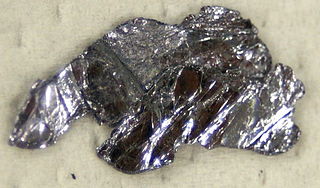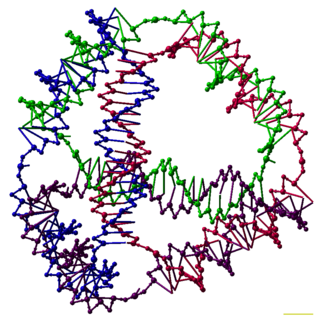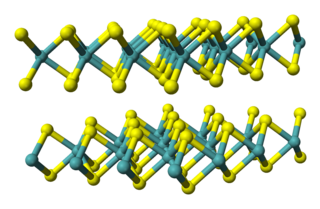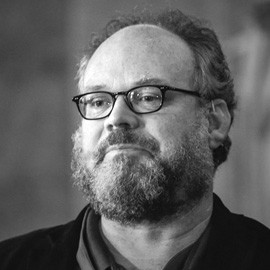Related Research Articles

Molybdenum disulfide is an inorganic compound composed of molybdenum and sulfur. Its chemical formula is MoS
2.

Nicholas Harrison FRSC FinstP is an English theoretical physicist known for his work on developing theory and computational methods for discovering and optimising advanced materials. He is the Professor of Computational Materials Science in the Department of Chemistry at Imperial College London where he is co-director of the Institute of Molecular Science and Engineering.

DNA nanotechnology is the design and manufacture of artificial nucleic acid structures for technological uses. In this field, nucleic acids are used as non-biological engineering materials for nanotechnology rather than as the carriers of genetic information in living cells. Researchers in the field have created static structures such as two- and three-dimensional crystal lattices, nanotubes, polyhedra, and arbitrary shapes, and functional devices such as molecular machines and DNA computers. The field is beginning to be used as a tool to solve basic science problems in structural biology and biophysics, including applications in X-ray crystallography and nuclear magnetic resonance spectroscopy of proteins to determine structures. Potential applications in molecular scale electronics and nanomedicine are also being investigated.
Single-photon sources are light sources that emit light as single particles or photons. These sources are distinct from coherent light sources (lasers) and thermal light sources such as incandescent light bulbs. The Heisenberg uncertainty principle dictates that a state with an exact number of photons of a single frequency cannot be created. However, Fock states can be studied for a system where the electric field amplitude is distributed over a narrow bandwidth. In this context, a single-photon source gives rise to an effectively one-photon number state. Photons from an ideal single-photon source exhibit quantum mechanical characteristics. These characteristics include photon antibunching, so that the time between two successive photons is never less than some minimum value. This behaviour is normally demonstrated by using a beam splitter to direct about half of the incident photons toward one avalanche photodiode, and half toward a second. Pulses from one detector are used to provide a ‘counter start’ signal, to a fast electronic timer, and the other, delayed by a known number of nanoseconds, is used to provide a ‘counter stop’ signal. By repeatedly measuring the times between ‘start’ and ‘stop’ signals, one can form a histogram of time delay between two photons and the coincidence count- if bunching is not occurring, and photons are indeed well spaced, a clear notch around zero delay is visible.
Luke Pyungse Lee is the Arnold and Barbara Silverman Distinguished Professor of Bioengineering, Biophysics, Electrical Engineering and Computer Science, at University of California, Berkeley. He is founding director of the Biomedical Institute for Global Health Research and Technology (BIGHEART) at the National University of Singapore.

Molybdenum diselenide is an inorganic compound of molybdenum and selenium. Its structure is similar to that of MoS
2. Compounds of this category are known as transition metal dichalcogenides, abbreviated TMDCs. These compounds, as the name suggests, are made up of a transition metals and elements of group 16 on the periodic table of the elements. Compared to MoS
2, MoSe
2 exhibits higher electrical conductivity.
Valleytronics is an experimental area in semiconductors that exploits local extrema ("valleys") in the electronic band structure. Certain semiconductors have multiple "valleys" in the electronic band structure of the first Brillouin zone, and are known as multivalley semiconductors. Valleytronics is the technology of control over the valley degree of freedom, a local maximum/minimum on the valence/conduction band, of such multivalley semiconductors.

Transition-metal dichalcogenide (TMD or TMDC) monolayers are atomically thin semiconductors of the type MX2, with M a transition-metal atom (Mo, W, etc.) and X a chalcogen atom (S, Se, or Te). One layer of M atoms is sandwiched between two layers of X atoms. They are part of the large family of so-called 2D materials, named so to emphasize their extraordinary thinness. For example, a MoS2 monolayer is only 6.5 Å thick. The key feature of these materials is the interaction of large atoms in the 2D structure as compared with first-row transition-metal dichalcogenides, e.g., WTe2 exhibits anomalous giant magnetoresistance and superconductivity.

Paul Anthony Midgley FRS is a Professor of Materials Science in the Department of Materials Science and Metallurgy at the University of Cambridge and a fellow of Peterhouse, Cambridge.
A two-dimensional semiconductor is a type of natural semiconductor with thicknesses on the atomic scale. Geim and Novoselov et al. initiated the field in 2004 when they reported a new semiconducting material graphene, a flat monolayer of carbon atoms arranged in a 2D honeycomb lattice. A 2D monolayer semiconductor is significant because it exhibits stronger piezoelectric coupling than traditionally employed bulk forms. This coupling could enable applications. One research focus is on designing nanoelectronic components by the use of graphene as electrical conductor, hexagonal boron nitride as electrical insulator, and a transition metal dichalcogenide as semiconductor.
A nanoelectromechanical systems mass spectrometer (NEMS-MS) is an instrument measuring the mass of analyte particles by detecting the frequency shift caused by the adsorption of the particles on a NEMS resonator.
Christian Schönenberger is a Swiss experimental physicist and professor at the University of Basel working on nanoscience and nanoelectronics.
Luis M. Campos is an Associate Professor in the Department of Chemistry at Columbia University. Campos leads a research team focused on nanostructured materials, macromolecular systems, and single-molecule electronics.

Peter Barker is an Australian-born British physicist.
Marija Drndic is the Fay R. and Eugene L. Langberg Professor of Physics at the University of Pennsylvania. She works on two-dimensional materials and novel spectroscopic techniques.
Pablo Jarillo-Herrero is a Spanish physicist and current Cecil and Ida Green Professor of Physics at Massachusetts Institute of Technology (MIT).
Tony Frederick Heinz is an American physicist.

Aleksandra Radenovic is a Swiss and Croatian biophysicist. Her research focuses on the development of experimental tools to study single-molecule biophysics. She is a professor of biological engineering at the École Polytechnique Fédérale de Lausanne (EPFL) and head of the Laboratory of Nanoscale Biology.
Rebekka Klausen is an American chemist who is the Second Decade Society Associate Professor at Johns Hopkins University. Her research considers carbon and silicon-based nanomaterials for optoelectronic devices. She was a finalist for the 2021 Blavatnik Awards for Young Scientists.
Jie Shan is a Chinese-American scientist who is Professor of Physics and Head of Graduate Studies at Cornell University. Her research considers the advanced characterization of two dimensional materials. She was elected Fellow of the American Physical Society in 2013.
References
- 1 2 "About Latha". Venkataraman Group.
- ↑ Venkataraman, Latha (January 1, 1999). "Electronic properties of one-dimensional conductors: A study of molybdenum selenide molecular wires". Bibcode:1999PhDT........65V – via NASA ADS.
- ↑ "Latha Venkataraman CV" (PDF). www.columbia.edu. 2021.
- ↑ "Venkataraman Named Gussman Professor of Applied Physics Chair". October 9, 2019.
- ↑ "Venkataraman, Latha". The David and Lucile Packard Foundation.
- ↑ "APS Fellow Archive". www.aps.org.